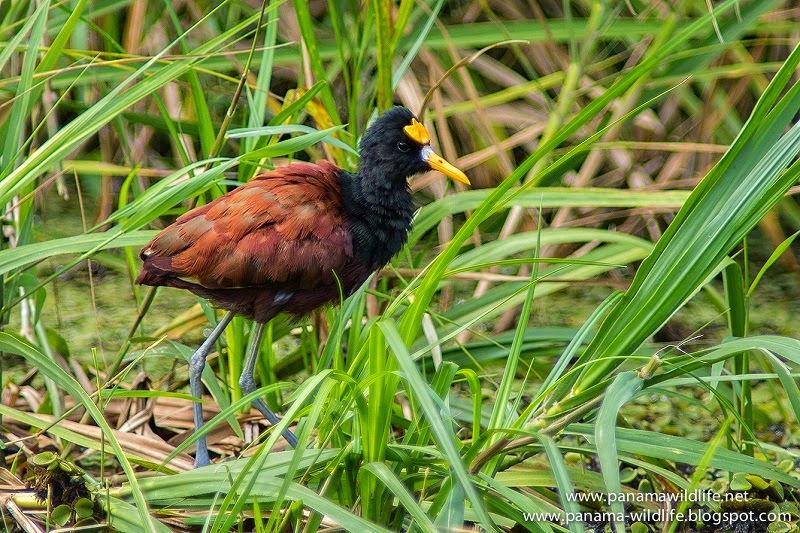Jacanas - Jacanidae family
Members of this small family occur in freshwater environments throughout
the world's tropics and in some parts of the subtropícs. Jacanas have
extraordinarily long toes that allow them to walk on floating vegetation,
where they feed on a variety of aquatic plants and animals and build their
nests.
Eight species of jacana are known from six genera.
They are identifiable by their huge feet and claws which enable them
to walk on floating vegetation in the shallow lakes that are their
preferred habitat. They have sharp bills and rounded wings, and many
species also have wattles on their foreheads.
The females are larger than the males; the latter take responsibility for incubation, and some species (notably the Northern Jacana) are
polyandrous.
However, adults of both sexes look identical.
They construct relatively flimsy nests on floating vegetation, and lay
eggs with dark irregular lines on their shells, providing camouflage
amongst water weeds.
Their diet consists of insects and other invertebrates picked from the floating vegetation or the water’s surface.
In Panama the two species of the Jacana genera occur. This genus comprise the only two jacanas of the Americas: the
Northern Jacana (Jacana spinosa), and the
Wattled Jacana (Jacana jacana). Both occur on
ponds and slow-moving streams with abundant floating vegetation but also grassy areas near them.
These birds are very similar to each other: about 22 cm (9 inches) long, with long necks and fairly long yellow bills. Adults are black and chestnut-brown, with pale yellow-green flight feathers that contrast conspicuously when a bird flies. Their legs are long and grayish, and as in all jacanas, their toes are extremely long, for walking on aquatic vegetation such as lily pads. They have
frontal shields and
wattles; differences in these are noticeable. Juveniles are brown above and white below, with a buff-white stripe above the eye and a dark stripe behind it. The northern jacana's range meets that of the wattled jacana in western Panama according to
A Guide to the Birds of Panama with Costa Rica, Nicaragua, and Honduras [Ridgely, Robert S.; Gwynne, John A., Jr. (1992)].




The Northern Jacana (Jacana spinosa) is a resident breeder from coastal Mexico to western Panama, and on Cuba, Jamaica and Hispaniola. It sometimes breeds in Texas, USA, and has also been recorded on several occasions as a vagrant in Arizona. In Jamaica this bird is also known as the 'Jesus bird', as it appears to walk on water. It has a dark chestnut-brown body with a black head and neck. In addition its bill has yellow patches and its forehead has a wattle, its bill has a white base, and has sharp spur on the bend of the wing. In flight, its yellow primary and secondary feathers are visible. In Panama it's common in Bocas del Toro and western Pacific from western Veraguas to Chiriquí.


The Wattled Jacana (Jacana jacana) is a resident breeder from western Panama and Trinidad south through most of South America east of the Andes. The adults have a chestnut back and wing coverts, with the rest of the
body mainly black, but J. j. hypomelaena race of Panama and northern Colombia has all the chestnut plumage replaced by black with some individuals having some chestnut on wings. As seen in pictures. In flight the greenish yellow flight feathers are
obvious. The yellow bill extends up as a red head shield and a reddish wattle, and the legs and very long toes are
dull blue-grey. There is a long sharp spur on the bend of the wing. In Panama it's common elsewhere from northern Coclé and western Veraguas eastward. Both species give noisy and harsh calls.
This picture shows the long claws, and yellow flight feathers visible on flight.
Males take responsibility for incubation in flimsy nests built on floating vegetation, can you see the eggs?








.jpg)


Comments
Post a Comment